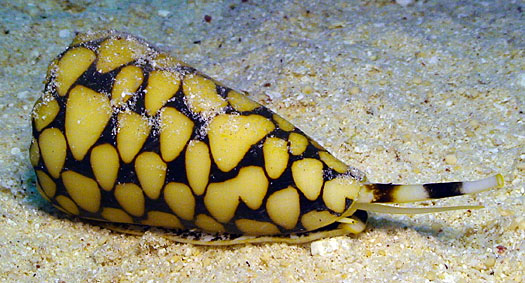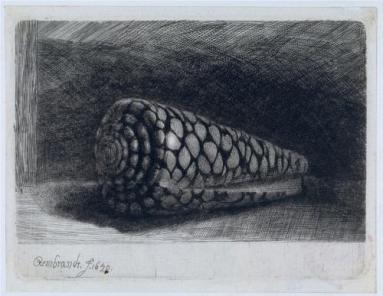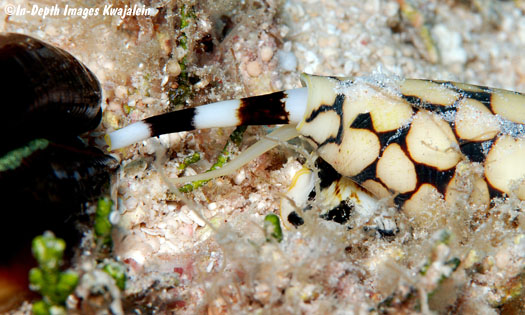Conus marmoreus
A Cannibalistic Cone Snail
 Welcome
to my website dedicated to the marbled cone snail, also known as
Conus marmoreus. It is a somewhat popular species
among biologists and shell collectors alike, which can probably
be attributed to its striking patterns and colors on its shell.
Dutch artist Rembrandt van Rijn famously made paintings and wood
carvings of this animal during the 17th century, as shown below.
The marbled cone snail usually has creamy white
almost-triangular shapes on a field of dark brown or blackish
color. At adulthood, its shell is typically around two to
three inches in length.
Welcome
to my website dedicated to the marbled cone snail, also known as
Conus marmoreus. It is a somewhat popular species
among biologists and shell collectors alike, which can probably
be attributed to its striking patterns and colors on its shell.
Dutch artist Rembrandt van Rijn famously made paintings and wood
carvings of this animal during the 17th century, as shown below.
The marbled cone snail usually has creamy white
almost-triangular shapes on a field of dark brown or blackish
color. At adulthood, its shell is typically around two to
three inches in length.
 C.
marmoreus is a triploblastic animal, meaning it has three
types of tissues. This is the case with most animals,
although some like the
Portugese Man o’ War jellyfish
only have two tissues and are diploblastic; others still, such
as
Plakortis simplex have no true tissues at all.
The marbled cone snail was the first cone snail described by
"The Father of Binomial Nomenclature" Carolus Linnaeus, and is
the type species for the genus Conus, or cone snails. This
means that it defines the genus for the purpose of determining
whether or not other species belong to that same genus.
This isn’t your ordinary snail, however. The marbled cone
snail is a molluscivore, which means it feeds on other mollusks.
To capture and handle its prey, it has adapted a very toxic
venom.
C.
marmoreus is a triploblastic animal, meaning it has three
types of tissues. This is the case with most animals,
although some like the
Portugese Man o’ War jellyfish
only have two tissues and are diploblastic; others still, such
as
Plakortis simplex have no true tissues at all.
The marbled cone snail was the first cone snail described by
"The Father of Binomial Nomenclature" Carolus Linnaeus, and is
the type species for the genus Conus, or cone snails. This
means that it defines the genus for the purpose of determining
whether or not other species belong to that same genus.
This isn’t your ordinary snail, however. The marbled cone
snail is a molluscivore, which means it feeds on other mollusks.
To capture and handle its prey, it has adapted a very toxic
venom.
 To learn more about where the marbled cone snail is found and
its general habitat, click here.
To learn more about where the marbled cone snail is found and
its general habitat, click here.
To gain insight on some adaptations the marbled cone snail has
undergone, click here.
To discover what C. marmoreus eats and how it acquires
its prey, click here.
To understand how C. marmoreus reproduces, click
here.
To read about the marbled cone snail’s interactions with other
species, click here.
To learn about the marbled cone snail’s venom and how it
disables prey, click here.
For the complete taxonomy and classification of C. marmoreus, click
here.
Visit MultipleOrganisms.net
Visit the UW-La Crosse Website
Contact Information